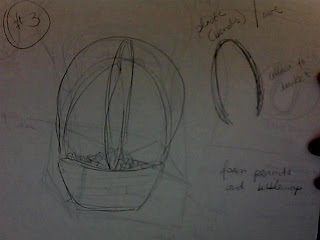1. “From the buildings in which we live and work, to the cars we drive, or the knives and forks with which we eat, everything we use was designed to create some sort of marriage between form and function.”
2. The folks at IDEO state that they are not experts in any given area. But, they do claim to be experts on the design process, which they apply to the innovation of consumer products.
3. After the team of designers is brought together, told the problem, and informed they have five days to “pull it off,” what phase of the design process do they immediately engage in?
Brainstorming
4. Give two examples of what the team members did during this phase.
a. velcro seats
b. privacy blinds
5. List five rules-of-thumb that IDEO employees follow when they share ideas during the brainstorming phase:
a. One conversation at a time
b. Stay focused
c. Encourage wild ideas
d. Defer judgement
e. Build on others' ideas
6. Why should wild (and sometimes crazy) ideas be entertained during the brainstorming phase?
Because it leaves a window of opportunity open for something new. Crazy ideas are always a good place to start and help create building blocks for more realistic ones. This way everything can be given a chance and there are more options as to what to try out. Ideas are always improved through trial and error.
7. After the brainstorming phase was over, the team narrowed down the hundreds of ideas by voting for those ideas that were not only “cool” but also buildable in a short period of time. What phase of the design process is this called?
8. IDEO believes that the ideas and efforts of a team will always be more successful than the planning of a lone genius.
9. Once the ideas were narrowed down and divided into categories, the group was split into four smaller teams. What phase(s) of the design process was each of these groups responsible for?
One group was responsible for shopping, another for checking out, another for safety, the last for finding what's being looked for.
10. The leaders at IDEO believe that playful behavior and a fun environment are two important reasons why their employees are able to think quickly and creatively to produce innovative results.
11. Sometimes, people come up with great solutions that work by trying their ideas first, and asking for forgiveness later.
12. Design is often a process of going too far and having to take a few steps back. What phase of the design process would the critique of the four mock-ups come under?
Refining and Communicating Results
13. Upon critique of the four teams’ models, it was obvious that none of the teams had developed an optimum solution. However, the people at IDEO believe that it is important to fail often in order to succeed sooner.
14. What percentage of the entire week’s time did it take to fabricate the final prototype?
About 43%
15. Instead of showering his design team with a tremendous amount of praise, what did the boss require his employees to do with their new design?
Improve it
16. Of all the things that we are surrounded by every day, what has not been placed through the design process?
Only nature; everything else requires the design process in some way.
Conclusion
1. What did you find to be the most impressive part of the team’s effort?
I really liked how well everyone got along and how ideas weren't ever shot down. It seemed like it was a lot of fun.
2. What advantages are there to having a design team with members that have non-engineering backgrounds?
They bring in a different perspective and remind the engineers of the consumer needs/wants.
3. There was a point in the process where a self-appointed group of adults stepped up, stopped the ideas, and redirected the group to break up into teams. Why was this done?
So that time wouldn't be wasted. The Brainstorming phase could have lasted forever had not someone taken control.
4. At the end of the video, Dave Kelly states, “Look around. The only things that are not designed are the things we find in nature.” Can you think of anything that would contradict this statement?
I cannot. I agree completely.








 - Being engineers, my partner, Christina, and I came to the conclusion that none of these were the right option for us. We very creatively decided to get a plastic bag and simply fill it with a bunch of crumpled paper. We put our egg in the middle and to everyone's surprise (but ours) it survived!
- Being engineers, my partner, Christina, and I came to the conclusion that none of these were the right option for us. We very creatively decided to get a plastic bag and simply fill it with a bunch of crumpled paper. We put our egg in the middle and to everyone's surprise (but ours) it survived! -If I had to change anything, I might try coming up with a way to aim the bag for the target a little better. When we dropped it, we were more concerned with whether or not the egg would break and we didn't really think about aiming right.
-If I had to change anything, I might try coming up with a way to aim the bag for the target a little better. When we dropped it, we were more concerned with whether or not the egg would break and we didn't really think about aiming right.





